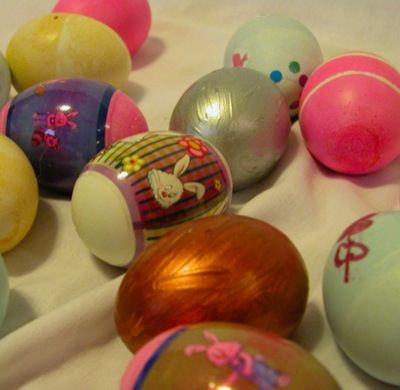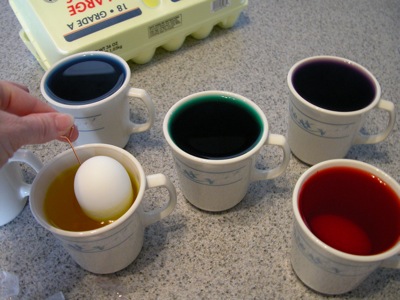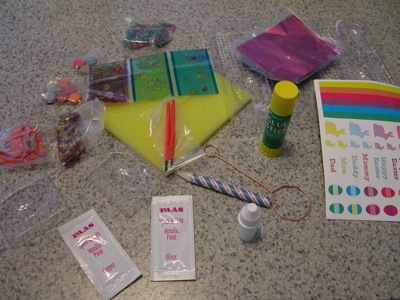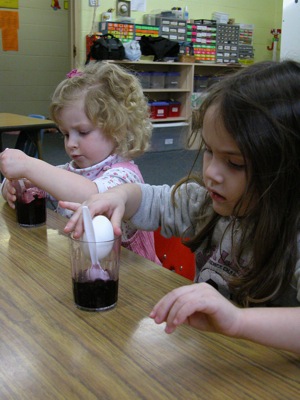Friday, March 30th, 2007
Make Easter Eggciting with an array of decorating techniques
By Shelley Grieshop

Photo by Shelley Grieshop/The Daily Standard
Metallic paint, plastic wraps, stickers - even just simple eggs dipped in dye - make a nice addition to any Easter basket. A variety of companies such as Paas make the job easy by selling all-in-one kits. More artistic Easter egg enthusiasts can find a wide range of ribbons, gems, glitter and other items to make unique varieties.
A plain, hard-cooked egg often turns into an eye-catching decoration at Easter time - just add a little dye, paint, foil, wax, sequins, even gold trim and gems.
Coloring Easter eggs is an ancient tradition. The egg - a symbol of fertility and new life - has been associated with the holiday for centuries. Originally, Easter eggs were painted with bright colors to represent the sunlight of spring and often given as gifts.
Thirteen century Macedonians were the first Christians known to use colored eggs in their Easter celebrations.
Today, the method chosen to color eggs - from soft pastel colors to bright neon - is a matter of choice. Some companies make the job easy with colored tablets that quickly dissolve in water. However, there are other options such as using food coloring and the natural dyes found in foods.
"I like using foods for color because if kids are helping, you don't worry about chemicals," said Emily Hines, a preschool teacher at Grace Land Preschool in Celina.
This year Hines let the youngsters in her class use blackberries, raspberries, blueberries and grape juice to color their hard-cooked eggs. The experiment resulted in eggs with a few seeds sticking to the shells and much less stress when the little ones began to lick their fingers.
Beets and cranberries can produce a pinkish-red tint; yellow onion skins create orange; lemon peels, carrot tops and ground cumin turn eggs a delicate yellow; and spinach leaves eggs a pale green. Berries of all kinds can be used as well as red cabbage, chili powder and Yellow Delicious apple skins.
Vinegar in the dye source helps brighten the color. Crayons or other types of wax can be applied before the dye so designs or words become visible after the dye is applied.
For a uniquely-decorated egg, a raw egg can be blown out and left empty for decorating with glue guns, ribbon, beads and glitter, and kept year after year.
Lois Clark, family and consumer sciences director at The Ohio State University Extension Office in Auglaize County, says egg decorating can be a fun, family-oriented activity, but she advises safety precautions.
"Food safety is very important," she says. "Be sure to keep your Easter eggs refrigerated."
Hard-cooked eggs should not be stored at room temperature for more than two hours. Clark advises using plastic eggs for Easter egg hunts. Eggs can contain salmonella, and if the conditions are right, the food poison can multiply and grow, she says.

Photo by Shelley Grieshop/The Daily Standard
To hard-cook eggs, bring them to a boil, remove from heat and allow them to remain covered in the hot water for about 15 minutes before rinsing with cold water. This method helps prevent shell cracking and an unattractive green ring from forming around the yolk.

Photo by Shelley Grieshop/The Daily Standard
It's best to use water that is warmer than the eggs for dyeing. Use food grade dyes including commercial egg dyes, liquid food coloring or fruit-drink powders. The longer the egg is left in the dye water, the more brilliant and deeper the hue. Refrigerate eggs immediately after decorating and do not eat eggs that are nonrefrigerated for more than two hours.

Photo by Shelley Grieshop/The Daily Standard
A variety of commercial products are available in stores for Easter egg decorating. Dye tablets, paint, stickers, cups and egg handling supplies are included in many packages.

Photo by Shelley Grieshop/The Daily Standard
Kaylin Avears, left, and Kyleah Giesege, students at Grace Land Preschool in Celina, dip their hard-boiled eggs in mashed berries and juice for a natural way to color eggs. A variety of fruits and vegetables can be used to dye eggs without chemicals. And if you get some on your hands, you can just lick it off.









